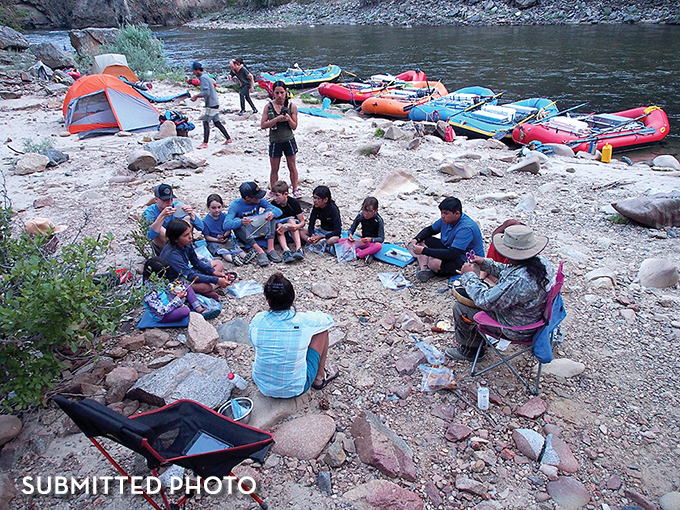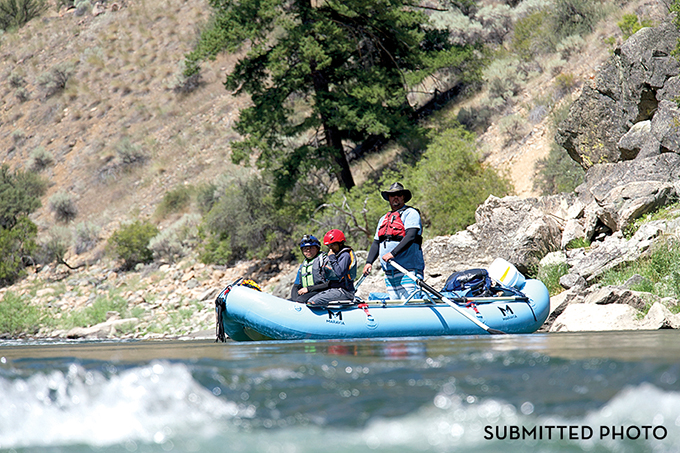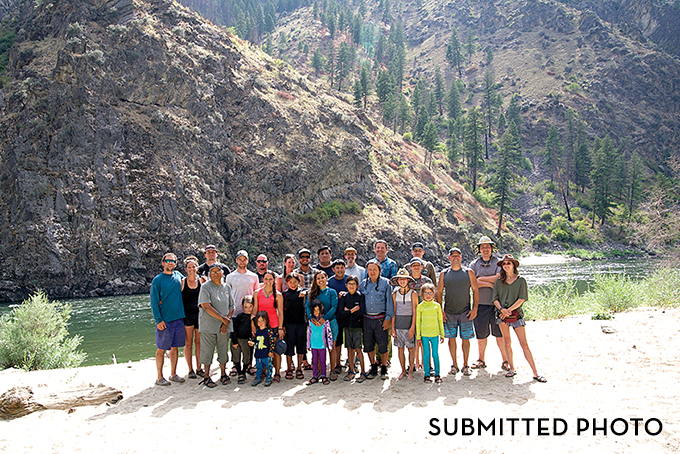Sho-Ban Tribes STrEAM Ecology returns newe back to river, incorporates curriculum

Instructor Ramon Murillo gives students a lesson.
By ROSELYNN YAZZIE
Sho-Ban News
FORT HALL — The Shoshone-Bannock STrEAM (Science, Technology, research, Education/Engineering, Art & Math) Ecology completed their first two trips this summer with a goal of returning Shoshone-Bannock people back to the river while implementing indigenous curriculum.
The purpose of the program is to experience reconnecting back to ancestral homelands where the Tukadeka once lived their day-to-day lives.
Sam and Jessica Matsaw are Shoshone-Bannock tribal members, educators, and experienced river guides, who coordinate the program.
Sam explained the idea for the program began 22 years ago with the purchase of two rafts by the Fish & Wildlife Program with the intention to get young people on the river. Things got busy for the program and nothing happened with it until now.
Sam said he’s had experience for a number years going down the river and sees a need in the community to get more students into Fish & Wildlife professions. He also writes proposals and grants to get funding for the project. The goal is to have a year round curriculum and have the summers working towards river projects. During the summer going out on the river, that would be the pinnacle of what they do and then come back and present those things to the community.
“Students would essentially be getting familiar with what they’re getting prepared for."
The trip is seven days long. It starts at Boundary Creek and travels 99 miles through wilderness and takes out at Cache Bar.

Rafting on the river.
Jessica’s education has compelled her to understand building an effective curriculum for indigenous students. She does an assessment before and after the program to see how the students grow. Her goal is to connect culture with STEM and different innovative fields used to learn on the river. She said she wants to be a good teacher to help the students, they’re already smart; it’s just finding the avenues for them to flourish.
Jessica said they think a lot about equity and typically the people who go out on the river are ones who have money.
“If you don’t have those resources you don't have access to your culture,” she said. “We’re trying to get that financial support so that way when people go to the river with us they’re not worried about anything.”
She said it’s also the people reclaiming their space. They’re trying to get away from the narratives of poverty and the negative of how non-natives portray indigenous people.
She said instead they want to celebrate who we are.
An example of one of the lessons taught was drum making and mathematics. She said it showed not only that our people could do math, but also that our people have been doing math since time immemorial.
“And that we’re mathematicians, and scientists, and historians, and all these things all at once,” she said, adding it shows the students in past and present tense they’re really smart.
Teaching the drum making was Ramon Murillo, a teacher at Sho-Ban High School. He’s been a drum maker for almost 40 years, his grandmother told him if you don’t make sure these arts are in place they can be lost.
Ramon’s main part on the project was to help with the culture and pass knowledge to the young people. He was also responsible for the spirituality part, making sure there was prayer daily for safety. He said being on the river is healing and helps to get in touch with the ancestors.
Another teaching lesson was on the Fort Bridger Treaty, which was taught by attorney Paul Echo Hawk, who told the youth about their rights on the river and hunting and fishing rights.
Tribal elder Diane Yupe was also present; she helped with the spiritual part as well as shared her archaeological knowledge of the pictographs they came across and the house depressions.
Room is left for learning to occur naturally as well. One lesson was on finding circles on the river and measuring them. They found an artifact bowl, demonstrating how the ancestors used circles.
Jessica said the learning is not just STEM, but there’s also policy, history, archaeology, and all kinds of different learning moments, which is why they bring an array of people within different professions.
Jessica said having the youth learn within a community was really important. They had a lot of emphasis on respect to others, to themselves, to the land and the ancestors. They talk a lot about gratitude; they talk about being a community and being together as a family on the river and why it’s important. She said it’s a strong support system they're trying to build community on and off the river.
All the students in the first trip were tribal youth, some from different tribes, but mainly Shoshone-Bannock and they ranged from age four years old to 21 years old. She said the age difference is important because it breaks down age segregation and learning. They look at it more traditionally as maturity. She said it gives the little students a chance to hang in with the older kids and for the older kids it gives them the opportunity to also be teachers.

Trip one participants.
A typical day on the river began with a prayer; Alonzo Bighorse was tasked with the honor of waking everyone up with a song. After they got up they ate breakfast and visited, at times the kids would participate in a learning lesson. They then packed up camp and put their equipment on the rafts. Before they leave the campsite Alonzo brings in another song to travel for the day.
As they traveled they would stop at cultural sites, most of them had pictographs they would discuss. Another part of the day was going through rapids. For lunch they stop somewhere nice and even take in some swimming and another teaching lesson. They set up a camp and have dinner and visit and another round of classroom activities.
Jessica said safety is enforced throughout the day along with cooperation and working together. The trips consist of 30 participants, on eight rafts.
Jessica said there are lots of opportunities for mentorship within the program to be rowers. She said it’s neat to see their confidence build.
Sam said it also provides opportunity for the young people to see it’s not just about STEM activities and college, but also they can stay on the river by being professional guides. They know a lot of the guiding companies and they’re looking for tribal youth to work for them.
The program is funded mainly through grants, funding also comes from Fish & Wildlife; University of Idaho; National Science Foundation; Oars Rafting Company (Idaho Branch, Curt Chang); Mark Deming at Northwest River Supplies.
Jessica said her dream is to see this program grow into a river school, where they will take youth on multiple trips down the river. She would like to have adequate funding, she would like to have rafts and be self-sufficient on the river.
Jessica said by doing this they would like to set up the young people to be successful in higher education or whatever it is they choose to do.
“Us going down the river we’re navigating and guiding our community, but we also want to do that within education too,” she said.





